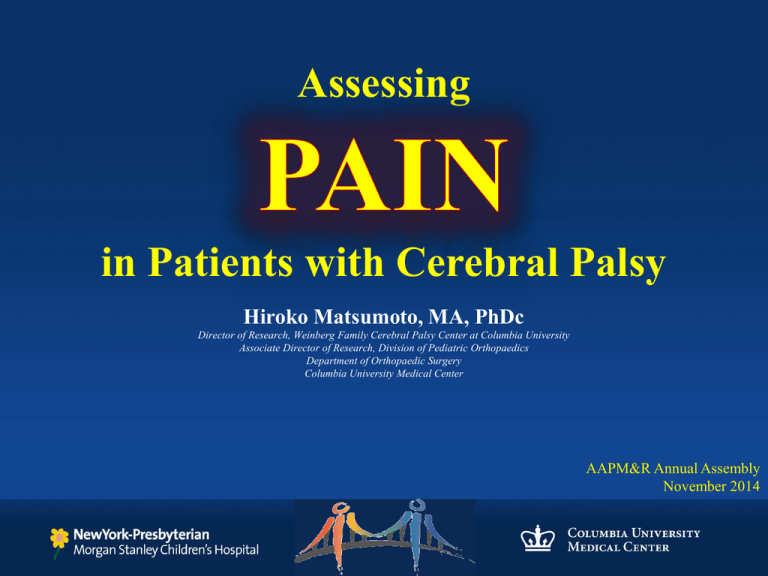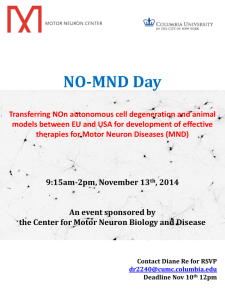What is PROMIS?
advertisement

Assessing in Patients with Cerebral Palsy Hiroko Matsumoto, MA, PhDc Director of Research, Weinberg Family Cerebral Palsy Center at Columbia University Associate Director of Research, Division of Pediatric Orthopaedics Department of Orthopaedic Surgery Columbia University Medical Center AAPM&R Annual Assembly November 2014 Columbia Orthopaedics Author Disclosures Research Support: Children’s Spine Foundation, SRS, POSNA, CPIRF Travel Support: Biomet, Medtronic, DePuy Synthes, Stryker Columbia Orthopaedics Introduction Patients frequently seek medical attention for pain, the #1 most common reason for visits to the ED (Chang et al, 2014). Experience of pain is subjective (Nakada et al., 2013; DeVon et al., 2014). Columbia Orthopaedics No Objective Measure of Physical Pain Functional MRI studies have shown that the same neural areas recruited in the experience of physical pain are associated with the experience of emotional pain (Eisenberger et al., 2003; Singer et al., 2004; Heckel et al., 2011). Columbia Orthopaedics Eisenberger et al., 2003 No Objective Measure of Physical Pain Although various inflammatory biomarkers may have higher levels during increased report of both acute and chronic pain, no one biomarker can currently assess pain w/ accuracy or certainty. Columbia Orthopaedics DeVon et al., 2014 The Gold Standard Because no objective measure to assess pain exists… Self-report is the gold-standard (Schiavenato and Craig, 2010). Columbia Orthopaedics Pain: Self-Report Tools Columbia Orthopaedics Wong-Baker FACES Pain Rating Scale Columbia Orthopaedics Wrong DL, Hockenberry-Eaton M, Wilson D, Winkelstein ML, Schwartz P: Wong’s Essentials of Pediatric Nursing, 6/e, St. Louis, 2001, P.1301 Numeric Graphic Rating Scale Columbia Orthopaedics McCaffery M, et al, Pain: Clinical Manual 1999, p. 16. Visual Analog Scale Columbia Orthopaedics Williamson A and Hoggart B. Pain: a review of three commonly used pain rating scales. Journal of Clinical Nursing 14, 2005; 798-804. Colored Analog Scale Columbia Orthopaedics Santos and Castanho, Am J Alzheimer’s Dis Other Demen June 2014, 29(4): 320-325. Verbal Rating Scale Columbia Orthopaedics Margo McCaffery, RN, MS, FAAN and Chris Pasero, RN, MSNc: Pain Clinical Manual, 2nd Edition, 1999, p.63. Pain Thermometer Columbia Orthopaedics Herr: Pain Med 2007 Oct-Nov;8(7):585-600. Where is Your Pain? Columbia Orthopaedics Pain, Vol 1, Melzack R, The McGill Pain Questionnaire: major properties and scoring methods 1975, 277-299. Brief Pain Inventory Columbia Orthopaedics http://www.npcrc.org/files/news/briefpain_short.pdf CP CHILD, Self-Report Caregiver Priorities and Child Health Index of Life with Disabilities Columbia Orthopaedics http://www.sickkids.ca/Research/CPCHILD-Questionaire/CPChild-Questionaire.html CP QOL-Child, Self-Report Cerebral Palsy Quality of Life for Children Columbia Orthopaedics http://www.cpqol.org.au/V2%20CPQOL%20child%20report%20Q%209-12.pdf Pain: Proxy-Report and Observational Tools Columbia Orthopaedics FLACC Pain Scale Columbia Orthopaedics Gomez et al., (2013) CP CHILD, Proxy-Report Columbia Orthopaedics http://www.sickkids.ca/Research/CPCHILD-Questionaire/CPChild-Questionaire.html CPS-NAID Chronic Pain Scale for Nonverbal Adults with Intellectual Disabilities Columbia Orthopaedics Burkitt, Breau, Salsman, Sarsfield-Turner & Mullen (2009) Abbey Pain Scale Columbia Orthopaedics The Australian Pain Society. http://www.apsoc.org.au/PDF/Publications/4_Abbey_Pain_Scale.pdf PADS Pain and Discomfort Scale for Pain Assessment among Adults with intellectual disability Columbia Orthopaedics Shinde et al., (2013) NCAPC The Non-Communicating Adult Pain Checklist Columbia Orthopaedics Lotan, Moe-Nilssen, Ljunggren, Strand (2010) DisDAT Disability Distress Assessment Tool Columbia Orthopaedics Regnard et al., (2006) CNPI Checklist of Nonverbal Pain Behaviors Columbia Orthopaedics Behavioral Measures of Pain Used in the following populations: – Infants, young children; – Children and adults w/ intellectual or communication needs. Observe and quantify: – Vocalizations; – Facial expressions; – Body movements. Document changes in patterns of daily life: – Eating; – Sleeping; – Play. Columbia Orthopaedics Symptoms versus HRQOL All of previous instruments (self-report and proxy/observational), assess pain symptoms rather than HRQOL. – Symptom: A physical sign or indication of disease; – Health Related Quality of Life (HRQOL): Physical, mental, emotional, social functioning, which takes into account impact of symptoms (Bjornson and McLaughlin, 2001). Both symptoms and HRQOL are patient-reported outcomes, meaning the patient reports his/her state of wellbeing. Columbia Orthopaedics Importance of HRQOL in CP Pain is highly prevalent among patients with CP (Novak et al., 2012, Schwartz et al. 1999, Engel et al., 2003). Pain is inadequately evaluated and treated in patients with CP (Hirsh et al., 2011). Important to measure HRQOL as opposed to symptoms alone: – Want to know impact of pain on patients’ ability to function in everyday life. Columbia Orthopaedics Static versus Dynamic Static Q’s Dynamic Q’s Columbia Orthopaedics Static versus Dynamic Static Static: Questions to follow do not change based on patient responses. Questions presented in same sequence, regardless of prior answers. Questionnaires Columbia Orthopaedics Static versus Dynamic Dynamic option: Questions are presented in changing sequence, with following sequence based on prior answers. Purpose: – Minimizes # questions; – Greater measurement precision; Presented as Computer Adaptive Test (CAT). Columbia Orthopaedics CAT Computer Adaptive Test Static versus Dynamic Previous instruments, although acceptable for pain assessment are static instruments. Columbia Orthopaedics PROMIS PROMIS: Patient-Reported Outcomes Measurement Information System. NIH-funded psychometric evaluation that has grown significantly over last several years: (http://www.hhs.gov/asl/testify/t051208a.html) – $82-million in 1997; – $90-million since 2004. PROMIS measures the following metrics: (NIHPromis.org) – Patient-reported outcomes: Objective, e.g. symptoms, function (http://www.nihpromis.org/measures/measureshome) – Health-related quality of life: Subjective, e.g. how a patient feels about their symptoms, function (http://www.nihpromis.org/measures/domainframework1) Columbia Orthopaedics What is PROMIS? A comprehensive instrument to assess pain and pain behaviors “PROMIS creates an opportunity for clinicians and patients to develop a common language around self-reported health status and in the process allow better assessment of the unique information from patients thereby enabling improved quality of care and quality of clinical research.” (NIHPromis.org) Columbia Orthopaedics What is PROMIS? A comprehensive instrument to assess pain and pain behaviors Columbia Orthopaedics What is PROMIS? A comprehensive instrument to assess pain and pain behaviors Columbia Orthopaedics What is PROMIS? A comprehensive instrument to assess pain and pain behaviors Universal self-reported pain scoring system, where: – Higher score means = higher pain intensity; – Lower score = lower pain intensity. Raw scores from short form or Computer Adaptive Test (CAT) are converted into scaled scores. Scaled scores are calibrated so that: (NIHpromis.org/faqs) – A score of 50-points is the average score of the US population; – 10 -points is equal to one standard deviation. Columbia Orthopaedics What is PROMIS? A comprehensive instrument to assess pain and pain behaviors One of the biggest advantages of the PROMIS scaled scores is that they have been adjusted so that adult and pediatric scores can be compared directly. Mean: 50 e.g. Raw score of (Peds pain interference) 40 e.g. Raw score of (Adult pain interference) 60 Scaled score of: 68% of population Columbia Orthopaedics What is PROMIS? A comprehensive instrument to assess pain and pain behaviors Item Bank Short Form 914 Q’s CAT Computer Adaptive Test Dynamic Q’s Static Q’s Columbia Orthopaedics PROMIS Adult Item Bank: e.g. from Pain Behavior Columbia Orthopaedics PROMIS Adult Item Bank: e.g. from Pain Interference Columbia Orthopaedics PROMIS Adult Item Bank: e.g. from Pain Intensity Columbia Orthopaedics PROMIS Pediatric Item Bank: e.g. from Pain Interference Columbia Orthopaedics Pain Self-Report in IDD Patients Communication of a patient’s pain to a treating clinician is limited by their ability to self-report (Schiavenato and Craig, 2010). Patients with Intellectual and Developmental Disabilities (IDD) have motor, sensory, and/or cognitive impairments leading to difficulty conveying their experiences and thus, their pain. Currently, no comprehensive method exists to assess the level of pain in all IDD patients. Columbia Orthopaedics COMPAs: Future Work COMPAs: NIH R01 grant – Creation of Outcome Measures in Pain Assessment; – Empowering Disabled Persons. Proxy Self Columbia Orthopaedics COMPAs: Future Work COMPAs: NIH R01 grant – Creation of Outcome Measures in Pain Assessment; – Empowering Disabled Persons. Proxy Self Columbia Orthopaedics COMPAs: Future Work Columbia Orthopaedics Key Summary Points Importance of measuring pain health related quality of life, not just pain symptoms. PROMIS is a robust and comprehensive NIH-funded tool to measure health related quality of life. Dynamic CAT versions of instruments allow for greater precision with less examiner burden than static instruments. PROMIS is a unique HRQOL tool with scaled scores to directly compare: – Pediatric v. adult scores; – Self v. proxy scores. Columbia Orthopaedics Thank You! Columbia Orthopaedics







